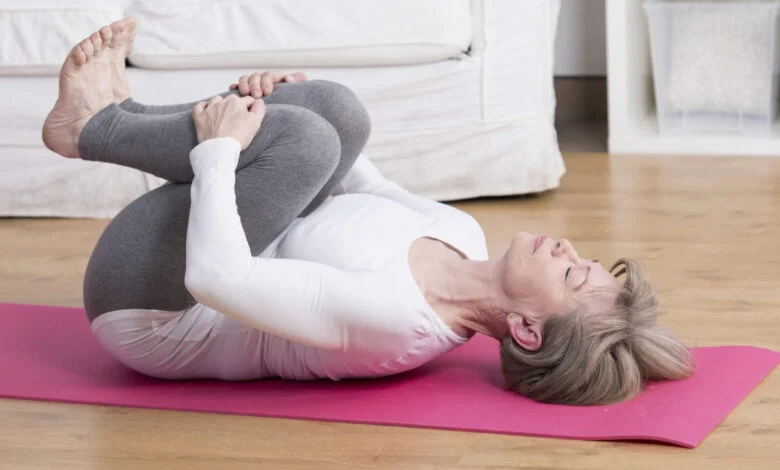Lower Back Pain Exercises Alleviating Discomfort and Strengthening Support

Lower back pain is a prevalent issue affecting millions worldwide often stemming from various factors such as poor posture muscle strain or injury. While seeking medical advice is crucial for specific cases incorporating targeted exercises into your routine can significantly alleviate discomfort and strengthen the muscles supporting the lower back.
Managing Pain in the Lower Back
Before delving into exercises understanding the underlying causes is essential. Factors like sedentary lifestyles improper lifting techniques weak core muscles or excessive sitting contribute to lower back pain. Exercises play a pivotal role in addressing these issues.
Benefits of Exercises for Lower Back Pain
Regular exercise not only reduces pain but also enhances flexibility improves posture and strengthens muscles leading to better spinal support. Moreover exercising releases endorphins acting as natural pain relievers.
Recommended Exercises
- Pelvic Tilts: Lie on your back with your knees bent. Tighten your abdominal muscles gently pressing the lower back against the floor and hold for a few seconds.
- Bridges: While lying on your back with knees bent lift your hips off the floor forming a straight line from shoulders to knees.
- Cat-Cow Stretch: Start on all fours arch your back up like a cat (cat pose) then slowly drop your belly down while lifting your head and tailbone (cow pose).
- Partial crunches: Place your hands behind your head and bend your knees while lying on your back. Maintaining your lower back on the ground raise your shoulders off the floor.
- Bird Dog Exercise: Begin on all fours extend one arm and the opposite leg simultaneously while keeping your hips and shoulders parallel to the floor.
- Hamstring Stretches: Tight hamstrings can contribute to lower back pain. Stretch them gently by sitting on the floor and reaching for your toes while keeping your back straight.
Precautions and Tips
- Consult a Professional: Before starting any exercise regimen consult a healthcare professional or physical therapist especially if you have chronic pain or any medical condition.
- Start Slowly: Begin with gentle movements and gradually increase intensity to avoid straining muscles.
- Maintain Proper Form: Incorrect posture during exercises can exacerbate pain. Focus on proper form to reap the maximum benefits.
- Consistency is Key: Regularity in performing exercises is crucial for long-term relief. Incorporate them into your daily routine for better results.
Causes lower back pain
Lower back pain can stem from a multitude of reasons making it a complex issue. One common cause is muscle strain often due to sudden movement’s heavy lifting or repetitive activities that strain the back muscles. Poor posture is another significant factor. Sitting or standing incorrectly for extended periods can strain the back leading to discomfort or pain. This strain might result from hunching over a desk slouching while seated or standing in an unsupported position.
Injuries such as sprains or fractures can directly impact the muscles, ligaments or bones in the lower back causing acute or chronic pain. Herniated or slipped discs where the soft tissue between vertebrae protrudes can also press on nerves triggering sharp pain in the lower back and legs. Underlying health conditions like arthritis can affect the spine causing inflammation and discomfort. Sciatica a condition caused by compression or irritation of the sciatic nerve often leads to radiating pain from the lower back down to the legs exacerbating lower back discomfort.
Addressing lower back pain often involves identifying and addressing these various factors through targeted exercises posture improvement lifestyle modifications and sometimes medical intervention or professional guidance.
Exercises helpful for lower back pain

Specific exercises play a pivotal role in alleviating lower back pain by targeting different aspects of physical health.
- Strengthening of the Core: Exercises targeting the abs, back extensors and pelvic muscles develop the core and support the spine. Greater muscular mass results in improved vertebral support which lessens strain on the lower back.
- Improved Flexibility: Stretching exercises enhance flexibility in muscles and ligaments around the spine and pelvis. Enhanced flexibility can reduce stiffness increase range of motion and alleviate tension in the lower back.
- Posture Enhancement: Exercises focusing on posture correction can retrain muscles to support the spine in a more neutral position. This helps distribute weight more evenly and reduces strain on the lower back.
- Core Stability: Strengthening the core muscles not only supports the lower back but also aids in overall body stability. Improved core stability leads to better balance and reduced risk of injury.
- Pain Management: Some exercises can directly target pain relief by releasing endorphins (natural painkillers) and improving blood flow to the affected area easing discomfort.
Some effective exercises for lower back pain
- Pelvic Tilts:
- Beginning Position: Lay flat on your back with your feet flat on the ground and your knees bent.
- Execution: Gently tighten your abdominal muscles and tilt your pelvis backward pressing your lower back into the floor.
- Movement:Slowly tilt your pelvis forward arching your lower back slightly off the floor. Hold briefly.
- Repetition: Repeat this rocking motion back and forth maintaining a controlled and gentle movement.
- Purpose: Pelvic tilts engage the abdominal muscles and help to stretch and strengthen the lower back.
- Bridge Exercises:
- Starting Position: Lie on your back bend your knees and keep your feet flat on the floor hip-width apart.
- Execution: Engage your core muscles, squeeze your glutes and lift your hips off the floor until your body forms a straight line from shoulders to knees.
- Hold: Maintain this position for a few seconds ensuring your shoulders, hips and knees are aligned.
- Lowering: Slowly lower your hips back down to the starting position.
- Repetition: Perform this movement focusing on engaging the core and glutes throughout.
- Purpose: Bridges strengthen the glutes, hamstrings and lower back muscles while improving core stability.
- Partial Crunches:
- Starting Position: Lie on your back with knees bent and feet flat on the floor, hands behind your head.
- Execution: Engage your abdominal muscles lift your shoulders off the ground and curl your upper body towards your knees.
- Breathing: Exhale as you lift inhale as you lower back down.
- Avoidance:Avoid pulling your neck use your abdominal muscles to lift.
- Repetition: Perform controlled movements feeling the abdominal muscles working.
- Purpose: Partial crunches target the abdominal muscles offering support to the lower back and improving core strength.
- Cat-Cow Stretches:
- Starting Position: Get on all fours with your hands beneath your shoulders and knees beneath your hips.
- Cat Pose: Inhale as you arch your back upward towards the ceiling tucking your chin to your chest.
- Cow Pose: Exhale as you dip your back down lifting your head and tailbone towards the ceiling.
- Flow: Alternate between these poses moving smoothly and slowly.
- Purpose: Cat-cow stretches help to improve flexibility and mobility in the spine relieving tension in the lower back.
- Yoga for Lower Back Pain:
- Improving Flexibility: Yoga involves various poses and stretches that target the entire body including the back muscles, hamstrings and hips. Poses as the downward-facing dog, children pose and seated forward bend gently stretch and release tension in the lower back improving flexibility over time.
- Core Strengthening: Many yoga poses require engaging the core muscles for balance and stability. Poses such as plank, boat pose and warrior poses to strengthen the abdominal muscles providing better support for the lower back.
- Mind-Body Connection: Yoga emphasizes mindfulness and breathing techniques which can help alleviate stress and tension often associated with exacerbating lower back pain.
- Stretching for Lower Back Pain:
- Targeted Stretches: Specific stretching exercises like hamstring stretches piriformis stretches and lower back stretches can directly target tight muscles contributing to lower back discomfort.
- Improving Range of Motion: Regular stretching sessions gradually increase the flexibility of muscles and ligaments around the lower back reducing stiffness and enhancing the range of motion.
- Relaxation and Pain Relief: Gentle stretching exercises can promote relaxation and release endorphins the body’s natural painkillers which may help reduce lower back pain.
- Benefits Over Time:
- Reduced Muscle Tension: Consistent yoga practice and stretching routines can alleviate chronic muscle tension in the lower back diminishing associated discomfort.
- Enhanced Posture: Improved flexibility and core strength gained from yoga and stretching can positively impact posture reducing strain on the lower back caused by poor alignment.
- Preventive Measure: Regular yoga and stretching exercises not only alleviate existing pain but also serve as preventive measures against future occurrences of lower back discomfort.
- Heavy Lifting without Proper Form:
- Risk of Strain: Engaging in heavy lifting activities especially without proper form can significantly strain the lower back muscles and ligaments.
- Overloading the Spine: Lifting heavy weights incorrectly can overload the spine leading to muscle spasms, strains or even more severe injuries like herniated discs.
- Importance of Technique: Using improper lifting techniques, such as rounding the back while lifting or not engaging the core muscles increases the risk of lower back injury.
- Exercises Causing Sharp Pain:
- Indicator of Potential Injury: Any exercise that induces sharp or shooting pain in the lower back should be avoided. This type of pain often indicates an underlying issue or an aggravated injury.
- Identifying Limitations: Certain movements or exercises may not suit everyone due to individual body mechanics or existing conditions. Pain during an exercise signals that it might not be suitable for your body at that moment.
- Avoidance for Safety: It’s crucial to stop any exercise immediately if it causes sharp pain as pushing through it may worsen the injury or strain the muscles further.
- Safety Precautions:
- Proper Warm-up: Always start with a proper warm-up routine to prepare the muscles and gradually increase the intensity of your workout.
- Maintaining Good Form: Focus on maintaining proper form and technique during exercises especially those involving the lower back to prevent unnecessary strain.
- Consultation and Guidance: Seeking guidance from a certified trainer physical therapist or healthcare professional helps in understanding which exercises are suitable and safe for your specific condition or limitations.
- Choosing Low-Impact Alternatives:
- Alternative Exercises: If certain activities or exercises put excessive strain on your lower back consider low-impact alternatives like swimming, cycling or using elliptical machines that place less stress on the spine.
- Core-Strengthening with Caution: While core-strengthening exercises are beneficial some may strain the lower back. Opt for modified or gentler versions that don’t exacerbate discomfort.
At The End
Lower back pain can be debilitating affecting daily activities and quality of life. However with targeted exercises aimed at strengthening core muscles improving flexibility and enhancing overall spinal support individuals can effectively manage and alleviate lower back pain. Remember a holistic approach that combines exercises with proper posture and lifestyle adjustments is key to achieving lasting relief.




